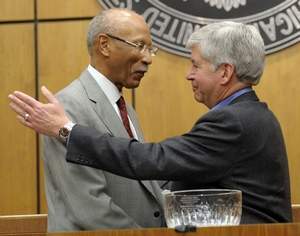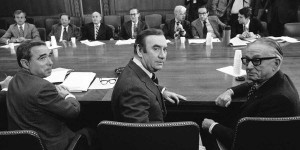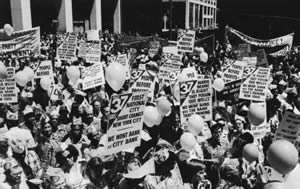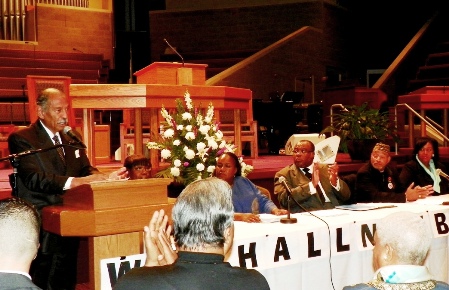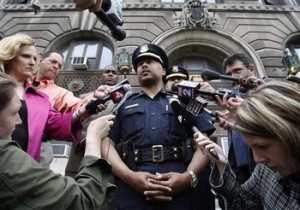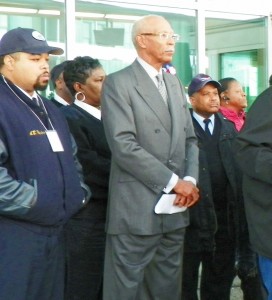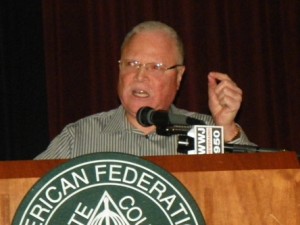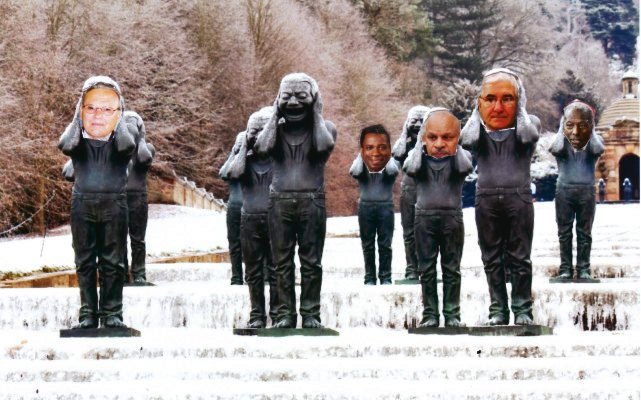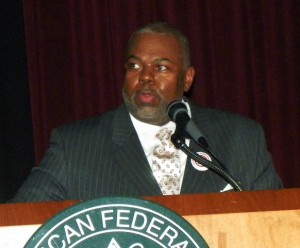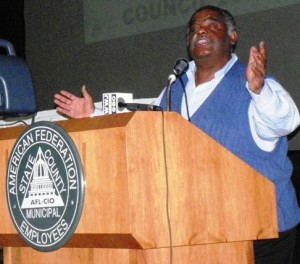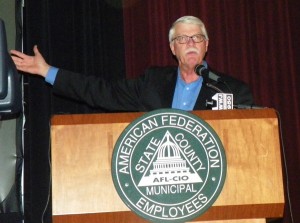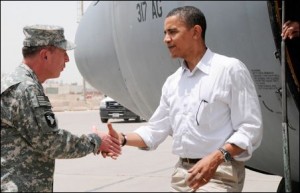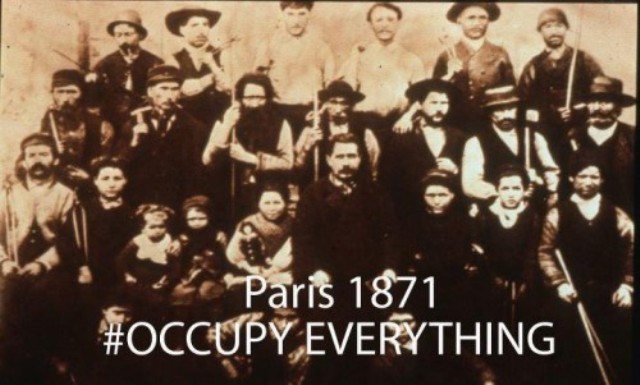
Attorney Andrew Paterson serves subpoenas to the Detroit review team, including Conrad Mallett (facing him) and State Treasurer Andy Dillon at center
Snyder, Dillon, review team to face judge Thurs. March 22 to “show cause” why they should not be found in contempt for violating OMA with proposal
By Diane Bukowski
March 14, 2012

State Treasurer Andy Dillon at review team meeting 3/13/12
DETROIT – A proposed consent agreement (CA), presented by State Treasurer Andy Dillon March 12 and 13 to Detroit Mayor Dave Bing, the City Council, and the state-appointed review team, under terms of Public Act 4, has outraged residents, the Mayor, U.S. Rep. John Conyers, Jr. (D-Detroit), and many others.
Wall Street banks clearly dictated the terms of the proposed “Fiscal Stability Agreement,” just as they dictated the city’s disastrous borrowing of $1.5 billion in pension obligation certificates in 2005. That action led to a 2009 default which the city forestalled by turning over its revenues from casinos and the state to a bank trustee.
For the agreement to expire, bond agencies must raise Detroit’s debt rating from its current junk status to at least one of the two highest levels, something not likely in the foreseeable future.

Atty. Jerome Goldberg says banks responsible; he also blasted proposed elimination of city DHS
“This is outrageous extortion by the banks,” Attorney Jerome Goldberg, who represents the city’s Association of Professional and Technical Employees, told the Council. “In Greece, the banks recently had to agree to a 75 percent reduction in debt payments from that government. Here, these are the same banks who have devastated Detroit neighborhoods with thousands of illegal and racist foreclosures.”
Councilwoman JoAnn Watson elaborated.
“Let’s have Detroit pay $6 million to the banks instead of the $600 million they have taken this year,” Watson said. “Public Act 4 is unconstitutional and illegal. The state owes us $220 million, how can they declare us in deficit when they owe US money?”

Councilwoman JoAnn Watson blasts proposal March 13, 2012
Marcus Cummings, the 23-year-old President of the East Schaefer I-75 association, told the Council, “It saddens my heart to see what has happened to Detroit over the years, from the destruction of our schools, to the theft of Cobo Hall and now this. I did not vote for a dictator. The state should be paying the money they owe us instead. I demand City Council tell the state to take their consent agreement and shove it.”

Marcus Cummings: take consent agreement and shove it!
Under the CA’s terms, Michigan Gov. Rick Snyder and Dillon want city officials to agree to install an unelected “Financial Advisory Board” (FAB). It would dictate the terms of a massive city “restructuring,” including the elimination of departments and many jobs and services, as well as possible sale of assets. The proposed agreement requires FAB approval of every city function, including budget, contracting, debt determinations, revenue sources, union contract negotiations, and pension and retiree benefit obligations.
The agreement purports to be a result of the review team’s findings, but there are in it no details of any financial assessment stating that the city is in an emergency situation. Dillon claims in the draft that the agreement would forestall the appointment of an emergency manager.

Dr. Delores Leonard
“I find it interesting that only last week signatures were submitted in Lansing to repeal Public Act 4,” Dr. Dolores Leonard said. She and many others also spoke against the turnover of the city’s Human Services Department functions to the Wayne Metropolitan Community Action Agency (WMCAA). (See VOD story at http://voiceofdetroit.net/2012/03/06/corrigan-demands-council-hand-over-control-of-city-dhs/).
They also objected to Mayor Bing’s recent decision to give the city’s $14 million in Head Start funding to WMCAA, despite the federal government’s recommendation that the city wait at least a year.
“I’m tremendously disappointed that this consent agreement proposed by Governor Snyder does not represent the spirit of partnership needed between the City and the State to resolve the City’s financial challenges,” Bing said in a statement. “It forfeits the electoral rights of the citizens of Detroit guaranteed by the democratic process.”

Mayor Dave Bing announces pension boards' agreement to forestall payments last year
He added, “[Snyder] is being disingenuous when he says this agreement leaves elected officials in charge of the City. In fact, the proposed, nine-member advisory board selects and “oversees” the functions of the City’s COO, CFO and Human Resources director – not the elected Mayor.”
Watson said Dillon personally delivered the March 13 version of the document to Council members’ offices five minutes before their scheduled general meeting at 10 a.m. She said only the Mayor’s office can present contracts to the City Council.
“Mayor Bing rejected this agreement,” Watson said. “But he said Gov. Rick Snyder told him that he has five members of the city council in his pocket. I want to know who those members are!”
Only Watson and Councilman Kwame Kenyatta later voted against a motion to have the Council’s Research and Advisory division review the proposal, saying the document itself is illegitimate. Other Council members including Saunteel Jenkins, Kenneth Cockrel, Jr, and Gary Brown said they were willing to re-negotiate terms of the agreement, despite the likelihood that PA 4 may soon be frozen.
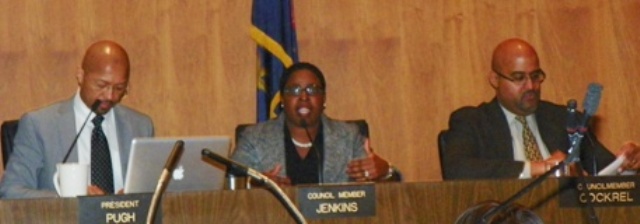
WHO ARE THE FIVE? Councilwoman Saunteel Jenkins argues for official review of consent agreement
Ed McNeil, chief negotiator for the city’s Coalition of Unions, said there was no necessity for the agreement because unions have already tentatively agreed to provisions in it including a reduction in the “head count” for City employees, reduction in private contractors, and changes in health care practices which could save the city $60 million a year. The tentative agreement, which has not yet been voted on by city workers, includes wage and health care concessions.

Brandon Jessup speaks at review team meeting 3/13/12
Brandon Jessup, CEO of Michigan Forward, which delivered over 226,000 petition signatures to the Secretary of State Feb. 29 to repeal PA 4 by referendum, questioned the timing of Dillon’s action. Once the state board of canvassers approves the signatures, Public Act 4 by law must be frozen until a November vote by Michigan residents. He said the Board has already counted the petitions, and now must select a sample to review for validity, which it is expected to begin doing by March 21.
Michigan Governor Rick Snyder has declared a March 27 deadline for the review team to present its findings to him.
Click on Detroit RT CAto read entire proposed agreement, and see summary below.

That afternoon, during an open review team meeting, Attorney Andrew Paterson, representing Robert Davis, presented subpoenas to Dillon and the team’s members, requiring them to appear before Ingham County Circuit Court Judge William Collette Thurs. March 22 at 9 a.m. Governor Rick Snyder is also being subpoenaed. (Click on RT subpoena to view document.)

Robert Davis, whose attorney Andrew Paterson subpoenaed the review team 3/13/12
They are to “show cause” why they should not be held in contempt of Collette’s earlier order declaring all proceedings of the Detroit review team null and void due to its violations of the Open Meetings Act.
“I don’t understand how they can be so lawless in this area,” Paterson told VOD. “Dillon has clearly been secretly preparing drafts of this agreement in violation of the Open Meetings Act.”
Judge Collette ordered that all review team meetings must be public. However, the minutes for the last public review team meeting of Feb. 28, 2012 state that Dillon created a subcommittee to discuss options for the team’s recommendations to the Governor. At the March 13 meeting, he told Davis that the subcommittee had not met. (Click on RT minutes 2 28 12 to read complete minutes, which do not include any discussion of the proposal Dillon submitted March 13.)
Dillon passed out copies of the document for the first time to the review team at their March 13 meeting, and said they would meet again Friday, March 15 after they have had a chance to digest it. However, his office said March 14 that no new meeting has yet been scheduled.
Mayor Bing and Detroit’s City Council were not present at the review team meeting. Instead, Dillon called on former Washington, D.C. Mayor Anthony Williams to make a presentation to the team endorsing the agreement.
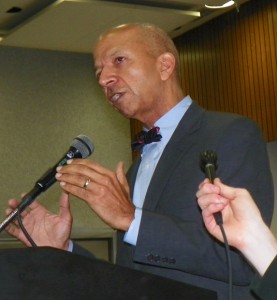
Former DC Mayor Anthony Williams endorses proposal despite Detroit Mayor Bing's opposition
Williams was mayor from 1999-2007, during which he executed a similar arrangement for his city, which still does not have home rule. He claimed the agreement is based on “Big MAC,” the agreement effectuated by New York Mayor Ed Koch and Wall Street banker Felix Rohaytn in 1978.
“Washington, D.C. was determined to be financially insolvent and unable to pay its bills,” Williams said. “If banks are going to loan money to a company, they want to see some changes in management.”
(Click on SO MUCH FOR THE URBAN RENAISSANCE WASHINGTON DC to read articlefrom The Progressive Review citing the deplorable conditions Black residents of Washington, D.C. have faced as a consequence of the re-structuring there. Click on Austerity and bankers coups, the NYC precedent to read analysis by author Doug Henwood of the New York City Wall Street takeover in 1978 and subsequent similar thefts of public municipal control. Articles will also be posted on VOD below.)
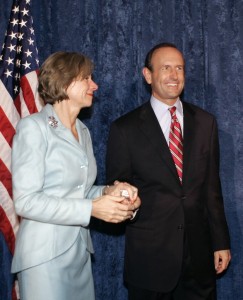
Michiganders Betsy and Dick Devos own the Amway Corporation; DeVos earlier ran for governor
Wikipedia says that after Williams’ term as mayor, “[he] entered into a partnership with the Washington-area investment bank Friedman Billings Ramsey Group, Inc. to form Primum Public Realty Trust, a real estate investment trust (REIT) focused on buying and leasing back government and not-for-profit real estate. In 2009 Williams announced he was stepping down as CEO and that Primum would be dissolved. He joined DC law firm Arent Fox on May 14, 2009 as Director of State and Local Practice, assisting governments and municipalities with securing stimulus money and managing their budgets.
“He has also been actively involved in local education initiatives, including serving on the boards of the nonprofit organizations D.C. Children First and the national nonprofit Alliance for School Choice.”

Debra Taylor tells the state review team PA4 is unconstitutional, at their meeting 3/13/12.
The Alliance for School Choice is the largest such organization in the United States. It supports the creation and expansion of school vouchers (for use by private as well as charter schools), corporate tax credits, and other school “choice” programs.
According to Think Progress, “The Alliance for School Choice is another [Dick and Betsy] DeVos front group founded to promote vouchers and serves as the education arm of AFC In 2008, the last date available for its financial disclosures, its total assets amounted to $5,467,064. DeVos used the organization not only for direct spending into propaganda campaigns, but to give grants to organizations with benign-sounding names so that they could push the radical school choice agenda. For example, in 2008 the organization gave $530,000 grant to the “Black Alliance for Educational Options” in Washington, D.C. and a $433,736 grant to the “Florida School Choice Fund.” This allowed DeVos to promote her causes without necessarily revealing her role. But it isn’t just the DeVos family that’s siphoning money into the Alliance for School Choice and its many front group patrons. Among its other wealthy funders include the Jaquelin Hume Foundation (which gave $75,000 in 2008 and $100,000 in 2006), the brainchild of one of an ultra-wealthy California businessman who brought Ronald Reagan to power, the powerful Wal Mart Foundation (which gave $100,000 in 2005, the Chase Foundation of Virginia (which gave $9,000 in 2007, 2008, and the same amount in 2009), which funds over “supports fifty nonprofit libertarian/conservative public policy research organizations,” and hosts investment banker Derwood Chase, Jr. as a trustee, the infamous oil billionaire-driven Charles Koch Foundation ($10,000 in 2005), and the powerful Wal Mart family’s Walton Family Foundation (more than $3 million over 2004–2005).” For whole article, click on http://thinkprogress.org/politics/2011/05/21/168363/billionaires-privatize-education/?mobile=nc.






